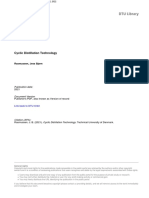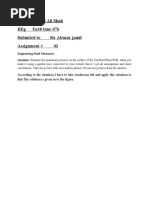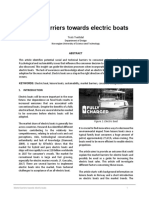Introductory Fluid Mechanics Taught Using A Carbur PDF
Introductory Fluid Mechanics Taught Using A Carbur PDF
Uploaded by
Usman Ali Usman AliCopyright:
Available Formats
Introductory Fluid Mechanics Taught Using A Carbur PDF
Introductory Fluid Mechanics Taught Using A Carbur PDF
Uploaded by
Usman Ali Usman AliOriginal Title
Copyright
Available Formats
Share this document
Did you find this document useful?
Is this content inappropriate?
Copyright:
Available Formats
Introductory Fluid Mechanics Taught Using A Carbur PDF
Introductory Fluid Mechanics Taught Using A Carbur PDF
Uploaded by
Usman Ali Usman AliCopyright:
Available Formats
See discussions, stats, and author profiles for this publication at: https://www.researchgate.
net/publication/315973400
Introductory Fluid Mechanics taught using a carburetor
Article · January 2017
DOI: 10.24908/pceea.v0i0.6541
CITATIONS READS
0 81
4 authors, including:
Andrew Trivett Cecile Devaud
University of Prince Edward Island University of Waterloo
17 PUBLICATIONS 233 CITATIONS 44 PUBLICATIONS 472 CITATIONS
SEE PROFILE SEE PROFILE
Some of the authors of this publication are also working on these related projects:
Turbulent Combustion Modelling View project
All content following this page was uploaded by Andrew Trivett on 04 July 2018.
The user has requested enhancement of the downloaded file.
Introductory Fluid Mechanics taught using a carburetor
Andrew Trivett, Andrew Milne, Cecile Devaud, Tyler Gallant
The typical fluid mechanics introduction in mechanical engineering covers basic fluid statics, forces on
submerged bodies, control volumes, continuity, conservation of momentum, conservation of energy,
Reynolds' transport theorem, internal and external flows. Students often struggle with the basic concepts
and how they might apply to a real system.
In the winter of 2015, a new set of open-ended labs were created for mechanical engineering students.
Teams of 3 or 4 students in a third-year class of 110 were each given a small engine, and removed the
carburetors. The series of labs had them discover some of the principles within the small carburetor from
a single-cylinder 4-stroke gasoline engine. Students were asked to explore and explain how the
carburetor worked, and then progressed through a set of hands-on labs culminating with a design
modification and performance measurement of a real carburetor. At each stage, the students applied
principles of fluid statics, control volumes, internal flow losses, and external flow drag to the physical
device.
The paper will describe the specific activities, and track the evolution of refinements to the experience
through three implementations of the same course by three different instructors. Student feedback and
measured evidence of learning will be reported to help justify the evolution of the activity. The
scalability of the activity will be discussed.
View publication stats
You might also like
- Slurry Transport Using Centrifugal Pumps (4th Edition) 2023Document494 pagesSlurry Transport Using Centrifugal Pumps (4th Edition) 2023khaledianmehdi648100% (1)
- Sample For Project Study - reviSEDDocument18 pagesSample For Project Study - reviSEDFranz Albina100% (3)
- Referat Za Prevod Markov ChainsDocument12 pagesReferat Za Prevod Markov ChainsЕмилиян ИвановNo ratings yet
- Introductory Fluid Mechanics Taught Using A Carburetor: January 2017Document2 pagesIntroductory Fluid Mechanics Taught Using A Carburetor: January 2017Usman Ali Usman AliNo ratings yet
- Introductory Fluid Mechanics Taught Using A Carbur PDFDocument2 pagesIntroductory Fluid Mechanics Taught Using A Carbur PDFUsman Ali Usman AliNo ratings yet
- Development of A Universal Pressure Drop Model in Pipelines Using Group Method of Data Handling-Type Neural Networks ModelDocument10 pagesDevelopment of A Universal Pressure Drop Model in Pipelines Using Group Method of Data Handling-Type Neural Networks ModelMohamed AlaaNo ratings yet
- Comparisons of Different Desiccant Wheel Modeling Methods A Review and Case StudyDocument13 pagesComparisons of Different Desiccant Wheel Modeling Methods A Review and Case StudyGrumpy Cat ZhangNo ratings yet
- (2016) GE Jet Engine Bracket Challenge: A Case Study in Sustainable DesignDocument14 pages(2016) GE Jet Engine Bracket Challenge: A Case Study in Sustainable Designswapnil pandeNo ratings yet
- Induction Motors For Crane ApplicationsDocument6 pagesInduction Motors For Crane ApplicationsJOHN MINKHANTNo ratings yet
- PHD KUDocument117 pagesPHD KUAzra BudalicaNo ratings yet
- Thesis in Hydraulic PDFDocument98 pagesThesis in Hydraulic PDFmaulik100% (1)
- Liquefied Petroleum Gas Cylinder Level Indicator and Transporting DeviceDocument14 pagesLiquefied Petroleum Gas Cylinder Level Indicator and Transporting DeviceAyorinde Oladele TiwaladeNo ratings yet
- Thermal Profileofa Marine Vessel Engine Room NEWTONfinalDocument22 pagesThermal Profileofa Marine Vessel Engine Room NEWTONfinal00024918No ratings yet
- The Network of Logistics Decisions: December 2005Document22 pagesThe Network of Logistics Decisions: December 2005Susma PantaNo ratings yet
- Evaluating Building Energy Performance - A Lifecycle Risk Management MethodologyDocument317 pagesEvaluating Building Energy Performance - A Lifecycle Risk Management MethodologyTheGimhan123No ratings yet
- Cyclic Distillation Technology: Rasmussen, Jess BjørnDocument163 pagesCyclic Distillation Technology: Rasmussen, Jess BjørnMaythee SaisriyootNo ratings yet
- Quantitative Models For Reverse Logistics Decision MakingDocument14 pagesQuantitative Models For Reverse Logistics Decision MakingJ NarenNo ratings yet
- FlyerDocument3 pagesFlyerSenadheera PiyanwadaNo ratings yet
- Numerical Scheme for modeling Natural Gas Flow in Cross-Border Pipelines ThesisDocument216 pagesNumerical Scheme for modeling Natural Gas Flow in Cross-Border Pipelines ThesisAbdo-almonaim AlghlamNo ratings yet
- Design and Finite Element Analysis of DoDocument9 pagesDesign and Finite Element Analysis of Doتوت خطريNo ratings yet
- Energies 13 05314 - VFDocument25 pagesEnergies 13 05314 - VFAmin RemaNo ratings yet
- 2014cepaperst48 PDFDocument66 pages2014cepaperst48 PDFTrần VânNo ratings yet
- Microcontroller Based Rotary Evaporator For Solution Growth: December 2014Document6 pagesMicrocontroller Based Rotary Evaporator For Solution Growth: December 2014AfridhausmanNo ratings yet
- Fluidized Bed Classroom Demonstration UnitDocument24 pagesFluidized Bed Classroom Demonstration UnitRahul DiasNo ratings yet
- E KayabasiB OzkulDocument5 pagesE KayabasiB Ozkulsupinya bieNo ratings yet
- Sun and Eames in ST of Energy 1995Document16 pagesSun and Eames in ST of Energy 1995Lucas RossiniNo ratings yet
- 5 IJARSET SaifaddeenDocument9 pages5 IJARSET SaifaddeenDr. Deo Karan RamNo ratings yet
- Mathematical Model Validation of Conventional Solar Still Under Egyptian ConditionsDocument8 pagesMathematical Model Validation of Conventional Solar Still Under Egyptian Conditionsأيمن الكزةNo ratings yet
- Scholarship at Uwindsor Scholarship at UwindsorDocument99 pagesScholarship at Uwindsor Scholarship at Uwindsorreodeepak0No ratings yet
- Ruhul RSCAdv Oct232015Document23 pagesRuhul RSCAdv Oct232015halajabar0No ratings yet
- Call For Papers in Special Issue "Advances in Physics Aware Machine Learning" in Computer Physics Communications (CPC)Document2 pagesCall For Papers in Special Issue "Advances in Physics Aware Machine Learning" in Computer Physics Communications (CPC)connect.to.smitravalNo ratings yet
- Modeling Industrial Thickener Using Computational Uid Dynamics (CFD), A Case Study: Tailing Thickener in The Sarcheshmeh Copper MineDocument9 pagesModeling Industrial Thickener Using Computational Uid Dynamics (CFD), A Case Study: Tailing Thickener in The Sarcheshmeh Copper MineOnesime MutebaNo ratings yet
- GeniusDocument10 pagesGeniusAnonymusNo ratings yet
- PROMFG43Document7 pagesPROMFG43yashkshatriya108No ratings yet
- Numerical Modeling of Supercavitating FlowsDocument41 pagesNumerical Modeling of Supercavitating FlowsKonstantinos MinasNo ratings yet
- A Comprehensive Resilience Assessment Framework For Hydrogen Energy Infrastructure DevelopmentDocument20 pagesA Comprehensive Resilience Assessment Framework For Hydrogen Energy Infrastructure Developmentthejaraju_rNo ratings yet
- CritiqueofASCE 7 2010WindLoadingProvisions NISTReport TN 1738Document21 pagesCritiqueofASCE 7 2010WindLoadingProvisions NISTReport TN 1738RONI PASSOS AYRESNo ratings yet
- Energy Efficient Passive Building A Case Study ofDocument18 pagesEnergy Efficient Passive Building A Case Study ofBrajesh BathriNo ratings yet
- Ahmad Syahrul MohamadDocument24 pagesAhmad Syahrul MohamadshawkishahrhNo ratings yet
- Achievements and Challenges in Cavitation ResearchDocument23 pagesAchievements and Challenges in Cavitation ResearchSaeed JavdaniNo ratings yet
- Petroleum Engineering Thesis ProposalDocument8 pagesPetroleum Engineering Thesis Proposalgxgtpggld100% (2)
- Berro3 IJHE 2015Document16 pagesBerro3 IJHE 2015AvglNo ratings yet
- State-of-the-Art of Advanced Distillation Technologies in ChinaDocument19 pagesState-of-the-Art of Advanced Distillation Technologies in ChinaDWNLD USRMLNo ratings yet
- TRB 1998Document10 pagesTRB 1998Bernd CastellarNo ratings yet
- Silo Design Codes - Their Limits and InconsistenciesDocument10 pagesSilo Design Codes - Their Limits and InconsistencieshazelbuddyNo ratings yet
- Hyperazeotropic Ethanol Salted-Out by Extractive DDocument7 pagesHyperazeotropic Ethanol Salted-Out by Extractive DMaria Catalina Pinzon SilvaNo ratings yet
- I RJ Mets 40300097618Document10 pagesI RJ Mets 40300097618design gipfelNo ratings yet
- Audiovisual Translation TodayDocument5 pagesAudiovisual Translation TodayMozar FilhoNo ratings yet
- On Some Imperative IEEE Standards For Usage of Natural Ester Liquids in TransformersDocument12 pagesOn Some Imperative IEEE Standards For Usage of Natural Ester Liquids in TransformersDante FilhoNo ratings yet
- Bekhme Dam Tunnels Protection: Gradevinar January 1988Document10 pagesBekhme Dam Tunnels Protection: Gradevinar January 1988inžinjerNo ratings yet
- A General Overview On Distillation Columns and Column CircuitsDocument5 pagesA General Overview On Distillation Columns and Column CircuitsLipQin YeoNo ratings yet
- Hydraulic Lifter Jack ProjectDocument30 pagesHydraulic Lifter Jack Projectkatariaaaryan3No ratings yet
- Implementing A Hydrogen Energy Infrastructure: Storage Options and System DesignDocument15 pagesImplementing A Hydrogen Energy Infrastructure: Storage Options and System DesignMohamad EzarinNo ratings yet
- Design and Development of Pneumatic Lab Activities For A Course On Fluid PowerDocument35 pagesDesign and Development of Pneumatic Lab Activities For A Course On Fluid PowerKhaled MahranNo ratings yet
- Impact of experimentally measured relative permeability hysteresisDocument17 pagesImpact of experimentally measured relative permeability hysteresisIgor Celso CelsoNo ratings yet
- Penstock Design ManyalDocument9 pagesPenstock Design ManyalSudish Lal MaskeyNo ratings yet
- Shivam Report 2Document30 pagesShivam Report 2alok sahuNo ratings yet
- Feasibility Study On Environmental Protection Reform of Ship SterDocument67 pagesFeasibility Study On Environmental Protection Reform of Ship SterPanagiotis GkezerlisNo ratings yet
- Sensors: Sensors in The Autoclave-Modelling and Implementation of The Iot Steam Sterilization Procedure CounterDocument17 pagesSensors: Sensors in The Autoclave-Modelling and Implementation of The Iot Steam Sterilization Procedure CounterUsman Ali Usman AliNo ratings yet
- Assignment #1Document4 pagesAssignment #1Usman Ali Usman AliNo ratings yet
- Lab Report 4.Document7 pagesLab Report 4.Usman Ali Usman AliNo ratings yet
- Course: Ic Engine LabDocument8 pagesCourse: Ic Engine LabUsman Ali Usman AliNo ratings yet
- Lab Report 1Document6 pagesLab Report 1Usman Ali Usman AliNo ratings yet
- Study Trip,: TeachingDocument1 pageStudy Trip,: TeachingUsman Ali Usman AliNo ratings yet
- ECAT 2011 OriginalDocument1 pageECAT 2011 OriginalUsman Ali Usman AliNo ratings yet
- Lecture # 06-Thermoelectric CoolingDocument18 pagesLecture # 06-Thermoelectric CoolingUsman Ali Usman AliNo ratings yet
- Autoclaves: Options and AccessoriesDocument2 pagesAutoclaves: Options and AccessoriesUsman Ali Usman AliNo ratings yet
- EEE 371 - Final ExamDocument2 pagesEEE 371 - Final ExamUsman Ali Usman AliNo ratings yet
- Samina Saqib W/O Saqib Usman Hno 22 Gulshan Rehman Society LHRDocument1 pageSamina Saqib W/O Saqib Usman Hno 22 Gulshan Rehman Society LHRUsman Ali Usman AliNo ratings yet
- CUI Introduction+FoE - QS World RankingDocument6 pagesCUI Introduction+FoE - QS World RankingUsman Ali Usman AliNo ratings yet
- COMSATS University Islamabad, WDocument6 pagesCOMSATS University Islamabad, WUsman Ali Usman AliNo ratings yet
- "Basics of Air Conditioning System and Energy Saving": Comsats University Islamabad, Wah CampusDocument1 page"Basics of Air Conditioning System and Energy Saving": Comsats University Islamabad, Wah CampusUsman Ali Usman AliNo ratings yet
- COMSATS University Islamabad, Wah Campus Terminal Examinations Spring 2020Document6 pagesCOMSATS University Islamabad, Wah Campus Terminal Examinations Spring 2020Usman Ali Usman AliNo ratings yet
- Line Tracking Robot AUTO-CAD 3D Design Project Exhibition: COMSATS Engineering Robotics CompetitionDocument2 pagesLine Tracking Robot AUTO-CAD 3D Design Project Exhibition: COMSATS Engineering Robotics CompetitionUsman Ali Usman AliNo ratings yet
- Line Tracking Robot: AUTO-CAD 3D Design Project ExhibitionDocument3 pagesLine Tracking Robot: AUTO-CAD 3D Design Project ExhibitionUsman Ali Usman AliNo ratings yet
- COMSATS University Islamabad, W: Ah CampusDocument1 pageCOMSATS University Islamabad, W: Ah CampusUsman Ali Usman AliNo ratings yet
- COMSATS University Islamabad, W: Ah CampusDocument1 pageCOMSATS University Islamabad, W: Ah CampusUsman Ali Usman AliNo ratings yet
- Name Farhad Ali ShahDocument6 pagesName Farhad Ali ShahUsman Ali Usman AliNo ratings yet
- Lecture 05-PseudoCodeDocument18 pagesLecture 05-PseudoCodeUsman Ali Usman Ali0% (1)
- Quantum SensingDocument3 pagesQuantum SensingritsNo ratings yet
- Building UtilitiesDocument41 pagesBuilding UtilitiesJara Mi SerinoNo ratings yet
- Multi Directional Portable Fork LiftDocument36 pagesMulti Directional Portable Fork LiftUnknown MailNo ratings yet
- VS Catalogue 2008 GBDocument548 pagesVS Catalogue 2008 GBmrorene100% (1)
- Datasheet - PG G-Drive NEF45SM2X - 69kWDocument13 pagesDatasheet - PG G-Drive NEF45SM2X - 69kWcesar saavedra saavedraNo ratings yet
- CHV Hydraulic Security Valve - EN - Neu - v2022 1Document3 pagesCHV Hydraulic Security Valve - EN - Neu - v2022 1IvanNo ratings yet
- Block 1Document93 pagesBlock 1chiscribdNo ratings yet
- 1 +night+aviation+lightsDocument8 pages1 +night+aviation+lightsAbdullah AnsariNo ratings yet
- Frequency Dispersion: Dielectrics, Conductors, and Plasmas: Carlos Felipe Espinoza Hern Andez Professor: Jorge AlfaroDocument23 pagesFrequency Dispersion: Dielectrics, Conductors, and Plasmas: Carlos Felipe Espinoza Hern Andez Professor: Jorge AlfaroRimple MaheyNo ratings yet
- R Rec M.2083 0 201509 I!!pdf eDocument21 pagesR Rec M.2083 0 201509 I!!pdf eJMColsNo ratings yet
- Waterloo South West Upgrade - 2017 LeafletDocument2 pagesWaterloo South West Upgrade - 2017 LeafletaleonalonsoNo ratings yet
- ISFO Science Paper 2020Level1G10Document8 pagesISFO Science Paper 2020Level1G10Anju Gupta100% (1)
- Physics 11 April EveningDocument14 pagesPhysics 11 April Eveningsaxena.sangeeta27No ratings yet
- Nominal Efficiency Limits For IE4 4.4.4 - Nominal Efficiency Limits (%) For 60 HZ IE4Document1 pageNominal Efficiency Limits For IE4 4.4.4 - Nominal Efficiency Limits (%) For 60 HZ IE4Easun - MR TechnicalNo ratings yet
- Cause and Effect of Air Pollution: Need Help With The Assignment?Document2 pagesCause and Effect of Air Pollution: Need Help With The Assignment?Quang PhạmNo ratings yet
- Unit I (Magnetic Field and Circuits - Electromagnetic Force and Torque)Document43 pagesUnit I (Magnetic Field and Circuits - Electromagnetic Force and Torque)UpasnaNo ratings yet
- Hvac SampleDocument7 pagesHvac SampleFabio BosioNo ratings yet
- SR1168Document73 pagesSR1168UltisolarNo ratings yet
- Industrial Training Report DeveshDocument64 pagesIndustrial Training Report DeveshDevesh SharmaNo ratings yet
- CH 101 Chemistry (3-1-0-8)Document25 pagesCH 101 Chemistry (3-1-0-8)akshayNo ratings yet
- To The Theory of Semiconductor Gas SensorsDocument5 pagesTo The Theory of Semiconductor Gas SensorsJohnny CrossNo ratings yet
- Thermodynamic Property RelationsDocument28 pagesThermodynamic Property RelationsNashit AhmedNo ratings yet
- Bala CVDocument3 pagesBala CVMukesh RavalNo ratings yet
- Stub Series Terminated Logic For 2.5 Volts (SSTL - 2)Document21 pagesStub Series Terminated Logic For 2.5 Volts (SSTL - 2)elberusNo ratings yet
- 16Document5 pages16JosafatNo ratings yet
- Market Barriers Towards Electric Boats: Truls TveitdalDocument10 pagesMarket Barriers Towards Electric Boats: Truls TveitdalPrem Kumar9701No ratings yet
- Atos Look Out UtilitiesDocument8 pagesAtos Look Out UtilitiesAbad AbanasNo ratings yet
- Vacuum Oil Purifiers: E865A SeriesDocument4 pagesVacuum Oil Purifiers: E865A SeriesdanielcelNo ratings yet
- ElectrostaticsDocument4 pagesElectrostaticssajiskNo ratings yet
- Sample 16718Document16 pagesSample 16718Avanish ShuklaNo ratings yet














































































































